The WD Black2 Review: World's First 2.5" Dual-Drive
by Kristian Vättö on January 30, 2014 7:00 AM ESTRandom Read/Write Speed
The four corners of SSD performance are as follows: random read, random write, sequential read and sequential write speed. Random accesses are generally small in size, while sequential accesses tend to be larger and thus we have the four Iometer tests we use in all of our reviews.
Our first test writes 4KB in a completely random pattern over an 8GB space of the drive to simulate the sort of random access that you'd see on an OS drive (even this is more stressful than a normal desktop user would see). I perform three concurrent IOs and run the test for 3 minutes. The results reported are in average MB/s over the entire time. We use both standard pseudo randomly generated data for each write as well as fully random data to show you both the maximum and minimum performance offered by SandForce based drives in these tests. The average performance of SF drives will likely be somewhere in between the two values for each drive you see in the graphs. For an understanding of why this matters, read our original SandForce article.
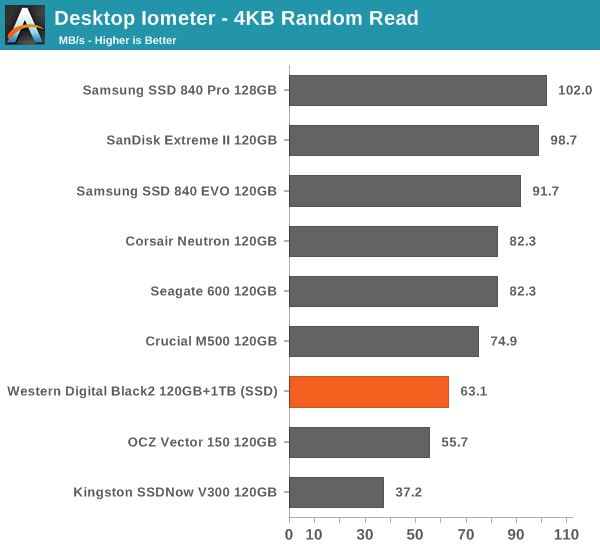

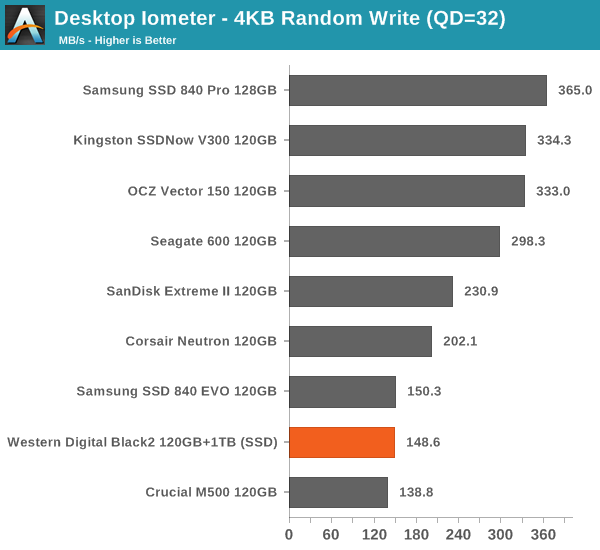
Random IO performance is relatively low per today's standards but not truly horrible. I was expecting something worse but the JMF667H turns out to be rather competitive with popular big brand drives like the Samsung 840 EVO and Crucial M500.
Sequential Read/Write Speed
To measure sequential performance I ran a 1 minute long 128KB sequential test over the entire span of the drive at a queue depth of 1. The results reported are in average MB/s over the entire test length.
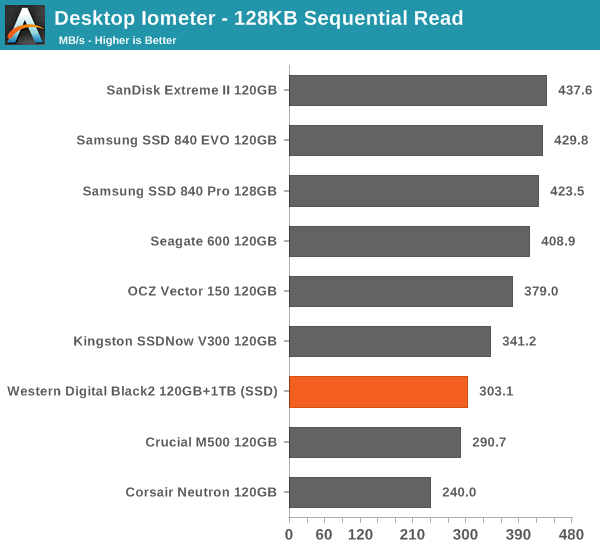
The same goes for sequential performance. It's not bad but there are far better options at 120/128GB.
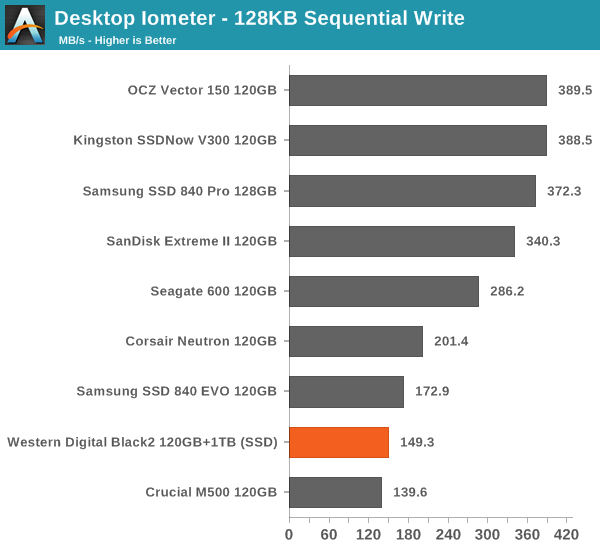
AS-SSD Incompressible Sequential Read/Write Performance
The AS-SSD sequential benchmark uses incompressible data for all of its transfers. The result is a pretty big reduction in sequential write speed on SandForce based controllers.
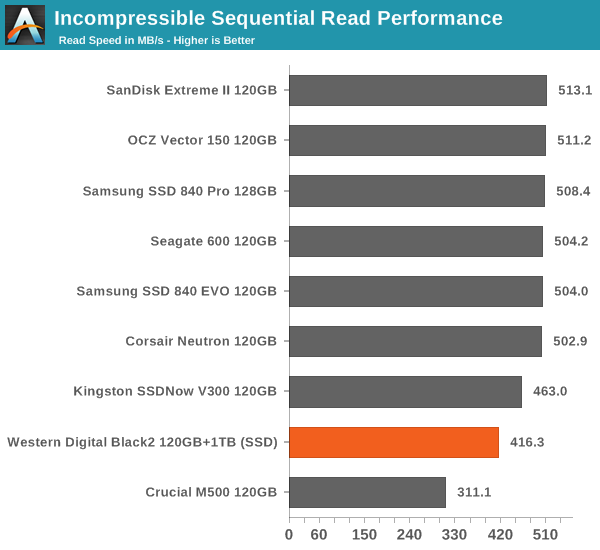











100 Comments
View All Comments
Kristian Vättö - Thursday, January 30, 2014 - link
There is no official Mac support, so maybe. I just tried using the drive in OS X and added my findings but unfortunately I don't have the tools to properly test it in a Mac.Maltz - Thursday, January 30, 2014 - link
To create a Fusion drive, you have to have two separate devices, not partitions. This drive shows up as a single device.name99 - Friday, January 31, 2014 - link
I don't think that's true. diskutil (in the command line) is crazy tolerant of gluing all sorts of weird shit together. The GUI is much more strict.What you MIGHT have to do if first run
diskutil ar create concat ...
to convert each partition to an AR2 partition. You can then run diskutil cs to fuse these partitions together. As a general principle, whenever diskutil refuses to do something with a raw partition, wrapping it in an AR2 partition will get the job done.
Calinou__ - Thursday, January 30, 2014 - link
This drive is the first Windrive.Panzerknacker - Thursday, January 30, 2014 - link
Very smart and interesting how they designed this. Considering the separation between SSD and HDD happens on LBA level and is based on the partition table, I don't understand why a driver is required though. This should work out of the box. Could you test this a bit more?Xajel - Thursday, January 30, 2014 - link
As they stated, it's a limitation of the SATA protocol, SATA is a point-to-point protocol, means you can't connect more than one device to the same SATA port... there's an un-required extension to the SATA protocol which is called SATA multiplier, basically it's a chip in the other hand of the SATA cable ( of course not in the cable it self ) that will take a single SATA cable and connect it to multiple drives... though it's not available in all chipsets as it's not required...I still hope WD will come with another version with such support, or who knows, maybe a small switch to select between which mode you want, but that will require more space for such switching... but my main concern with these approaches is when one of the drives fails ( after warranty goes )... you will loose a hell !!
In the mean while, I feel the best solution is to find a laptop with both mSATA and 2.5" SATA so you will not worry about one of the drives failing and you loose both...
Panzerknacker - Thursday, January 30, 2014 - link
No this is not true. As they stated, separation between the SSD and HDD happens INSIDE the drive, by means of a system which sends I/0 targeted at the first 120gb of the drive's sectors to the SSD, and I/0 targeted at the rest of the sectors to the HDD. The system in which the Black 2 is installed should see only one 1120GB disk with 2 partitions (default). I don't understand why this would require a driver because the system does NOT know or need to know what's going on inside the drive as long as you don't mess with the default partition layout.DanNeely - Thursday, January 30, 2014 - link
The 2 partitions in one drive thing only happens after the drivers are installed. It's implemented using port multiplication which means that it has 2 different drives hanging off a single sata port. Some older computers didn't come with support for it, so WD used the looks like only a 120GB drive by default kludge for wider spread compatibility.While I understand the need for back compatibility, and wouldn't have a problem if they defaulted to legacy support; I do wish they provided an option either in a configuration app or via a jumper selection that would let it expose itself as a pair of port multiplied drives for systems that do support the feature without having to go through WDs indirection layer.
extide - Thursday, January 30, 2014 - link
Yeah but thats not the case. Panzerknacker is right. If it truly was port multiplication then the computer would see two individual drives. Instead it sees one big one. Theoretically it should be able to work without a driver and show up as a single drive, its kinda like a JBOD of the SSD + HDD built into the drive. That shouldn't need any drivers.Also, is there linux support for this?
Kristian Vättö - Thursday, January 30, 2014 - link
Not officially but once the partitions have been set in Windows they show up fine in Linux and OS X.